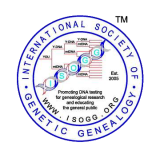Visual Phasing Post-Initiation Consultation Stage (Borland Genetics)
From ISOGG Wiki
After project creation, Creeper activation, and the subsequent initiation of the Relationship Manager, the next stage in the Visual Phasing workflow assesses the best approach for DNA reconstruction. This assessment is based on the available DNA resources within the system. The main consideration is whether to proceed with the Visual Phasing Smart Project or if another type of project or projects would be more fitting to achieve the desired grandparent reconstructions.
Contents
When Both Parents Have Factory Kits In the System
- If both target parents' DNA kits are in the Borland Genetics database, the workflow is more straightforward. In these cases, two Reverse Phase Smart Projects are advised, one for each parent.
- Reverse Phasing phases a parent against their children, determines recombination points, and aligns segments between these points to reconstruct the grandparent kits from extractions performed on the phased in-phase and evil twin kits.
- If the user isn't the curator of one or both parent donors, they'll require collaboration from the respective curator(s).
When One Parent Has a Factory Kit In the System
- If even one parent has a factory kit, visual phasing will not be the most effective method for reconstructing the target grandparents.
- The user is accordingly advised to start a Reverse Phase Smart Project for the tested parent and utilize the Missing Parent tool for the untested parent.
- Users are also directed to a generic Creeper-type project. This uses the Borland Genetics reconstruction method in its general form to reconstruct grandparents on the side of the untested parent.
- Collaboration with the curator is essential if the user does not administer the tested parent's data.
When Neither Parent Has Factory Kits In the System
- If neither parent has factory kits, the Creeper assesses whether any sibling donors have tested children in the system. This can streamline the workflow, as more of that sibling's DNA can be phased, enhancing the final reconstruction of the target parents and grandparents. If one or more such child is detected, the user is simply notified at this juncture that the child’s data will be included in the project, and then the Creeper will proceed to the first phasing stage.
- If no parents or children of the siblings are detected, the Consultation phase is bypassed, leading directly to the first phasing stage.
In conclusion, this stage provides users with the most efficient pathway for grandparent DNA reconstruction, taking into account the data at hand. The recommendations aim to utilize resources effectively while simplifying the reconstruction process.
